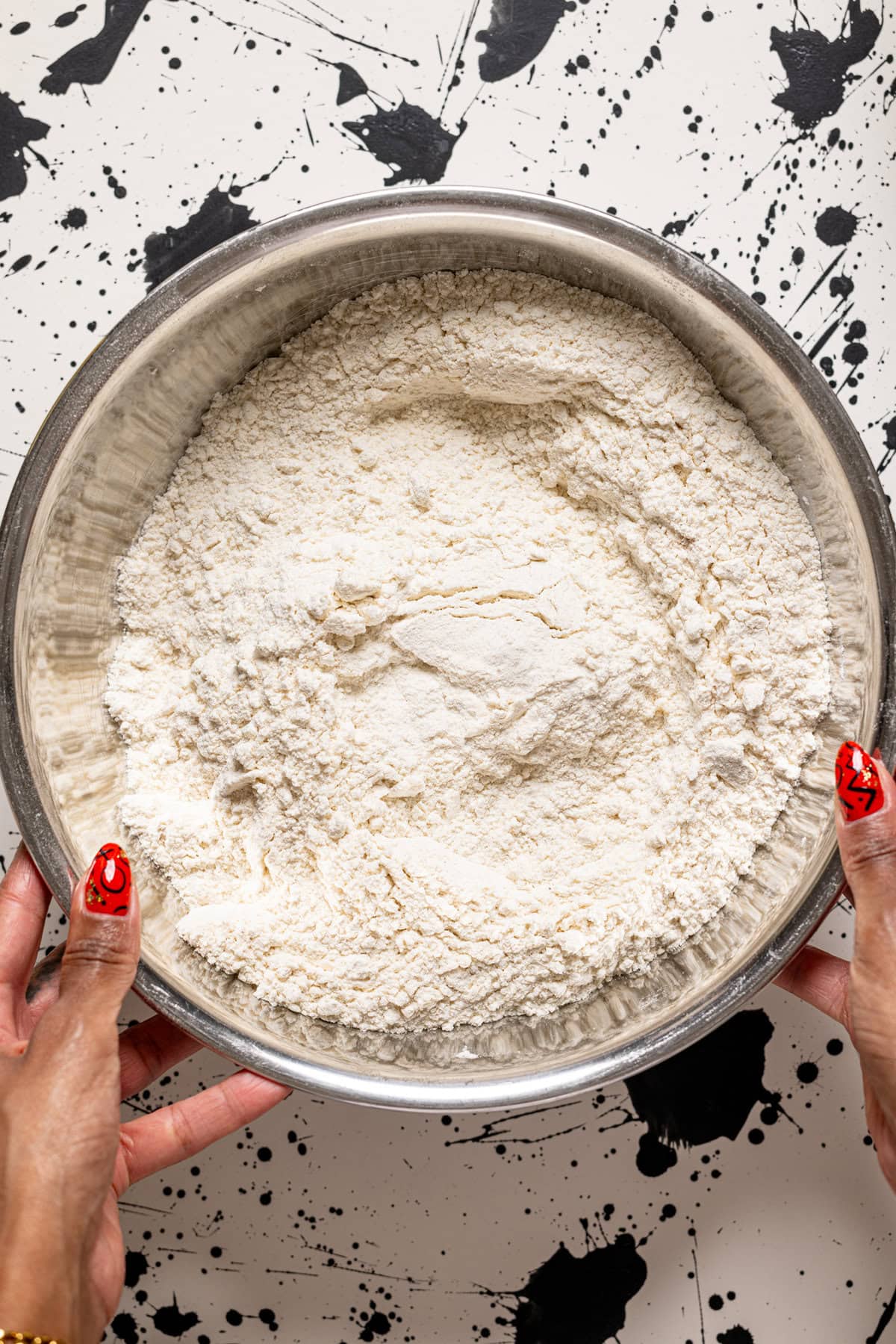
What is Bread Flour + Best Substitutes
DISCLAIMER: This post may contain affiliate links, which means that I make a small commission off items you purchase at no additional cost to you. Please read my policy page!
What is Bread Flour + Best Substitutes
Bread flour is the secret behind bakery-worthy breads, with its higher protein content that creates that signature chewy texture and perfect rise. But what happens when you're out of it or need substitutes for bread flour? Don’t worry—you’ve got options!

Bread flour is a pantry staple for many bakers, especially those who love whipping up artisan breads, pizza doughs, bagels or any recipe that calls for that perfect chewy texture + rise. But what exactly is bread flour, and what do you do if you’re out of it? Don’t worry y'all—this guide has you covered!
Jump to:

What is Bread Flour?
Bread flour is a high-protein flour specifically designed for baking recipes that require a strong gluten structure. With a protein content of around 12-14%, it has more protein than all-purpose flour, which typically ranges from 8-11%. This extra protein helps create more gluten, which gives bread its signature chewy texture and ability to rise beautifully.
Bread flour is a must-have for recipes like:
- Artisan breads (like sourdough and baguettes)
- Pizza dough
- Bagels
- Dinner rolls
- Pretzels
The high protein content makes bread flour a go-to for recipes requiring structure, elasticity, and a hearty crumb.

How is Bread Flour Different from All-Purpose Flour?
The primary difference between bread flour and all-purpose flour lies in the protein content. Bread flour’s higher protein level makes it ideal for yeast-based recipes that need strong gluten development. On the other hand, all-purpose flour is more versatile, with a lower protein content that works well for cookies, cakes, and other baked goods with a softer texture.
In a pinch, you can substitute one for the other, but the results may vary slightly. Using all-purpose flour in a bread recipe might lead to a softer, less structured loaf, while using bread flour in cookies could make them a bit chewier.

Best Substitutes for Bread Flour
If you’re out of bread flour or can’t find it at the store, don’t panic! There are several substitutes you can use to achieve similar results.
1. All-Purpose Flour
The easiest substitute for bread flour is all-purpose flour, as it’s likely already in your pantry. While it has a lower protein content, it can still work in most bread recipes. To make it closer to bread flour, you can add a bit of vital wheat gluten.
How to substitute:
- For every cup of bread flour, use 1 cup of all-purpose flour.
- Optional: Add 1 teaspoon of vital wheat gluten per cup of all-purpose flour for better results.
When to use: Great for quick breads, soft dinner rolls, and lighter-textured loaves.
2. Whole Wheat Flour
Whole wheat flour can replace bread flour for a heartier, more rustic flavor and texture. Keep in mind, it absorbs more liquid and can make your baked goods denser, so you might need to adjust the recipe.
How to substitute:
- Use an equal amount of whole wheat flour but add 1-2 tablespoons of extra liquid per cup of flour.
When to use: Perfect for whole-grain breads and recipes where a nutty flavor is desired.

3. Vital Wheat Gluten + All-Purpose Flour
If you have vital wheat gluten on hand, you can essentially make your own bread flour! Vital wheat gluten is the concentrated protein found in wheat, and adding a small amount to all-purpose flour mimics bread flour’s structure.
How to substitute:
- Mix 1 cup of all-purpose flour with 1-2 teaspoons of vital wheat gluten.
When to use: Ideal for recipes where structure is key, like bagels or pizza dough.
4. Spelt Flour
Spelt flour is an ancient grain that’s high in protein and gluten, making it a suitable substitute for bread flour. However, its gluten structure is slightly weaker, so your dough might not rise as high.
How to substitute:
- Use 1:1 for bread flour but be prepared for a slightly different texture.
When to use: Best for artisan breads or recipes where a mild, nutty flavor complements the dish.
5. Self-Rising Flour
Self-rising flour isn’t an ideal substitute for bread flour, but in a pinch, it can work for non-yeast recipes. It already contains baking powder and salt, so adjust the recipe accordingly.
How to substitute:
- Use an equal amount of self-rising flour, but omit any added leavening agents (like baking powder or soda).
When to use: Suitable for quick breads, biscuits, or rolls.

6. Pastry Flour or Cake Flour
Pastry or cake flour isn’t a perfect substitute for bread flour due to its low protein content. However, if it’s all you have, you can blend it with some vital wheat gluten for better results.
How to substitute:
- Mix 1 cup of pastry or cake flour with 1 tablespoon of vital wheat gluten.
When to use: Only use when absolutely necessary for lighter bread recipes.
7. Gluten-Free Flour Blends
For those with gluten intolerance, there are many gluten-free flour blends available. Look for blends specifically designed for bread baking, as they often include xanthan gum or other binding agents to mimic gluten’s elasticity. My all time favorite is Bob's Red Mill Gluten Free 1-to-1 Baking Flour
How to substitute:
- Use a 1:1 ratio, but follow the specific instructions on the gluten-free blend packaging.
When to use: Ideal for gluten-free breads and pizza dough.

Tips for Substituting Bread Flour
When swapping out bread flour, here are a few tips to ensure the best results:
- Add extra kneading time. Lower-protein flours need more kneading to develop gluten. Don’t skip this step if you want a good rise and texture.
- Adjust liquid. Some flours absorb more or less liquid than bread flour, so keep an eye on your dough. Add water or flour gradually until it’s the right consistency.
- Expect texture differences. Substituting flours might result in a slightly different texture. Embrace the variation—it’s part of the fun of baking!
- Experiment with blends. Don’t be afraid to mix flours to achieve the right balance of flavor, texture, and rise.
Bread Flour and Substitutes Q + A's
Yes, all-purpose flour works well for pizza dough, but your crust may be a bit softer and less chewy. Adding vital wheat gluten can help mimic bread flour’s results.
All-purpose flour with a teaspoon of vital wheat gluten per cup is the best substitute for sourdough. Whole wheat flour can also work if you don’t mind a denser texture.
Yes! Bread flour can replace all-purpose flour, especially in recipes where a chewier texture is desired. Just note that cookies and cakes may turn out a bit denser.
Store bread flour in an airtight container in a cool, dry place. For long-term storage, keep it in the freezer to prevent it from going rancid.

THAT'S A WRAP!
Bread flour is a powerhouse ingredient for baking hearty, chewy breads and other delicious treats. But when you’re in a pinch, there are plenty of substitutes to save the day! Whether you’re mixing in vital wheat gluten, using whole wheat flour, or experimenting with spelt, you’ll find that your bread-baking adventures can continue without missing a beat. Now go forth and bake your heart out!
More Food + Wellness Insights You Might Enjoy
If you loved learning about What Bread Flour Is + Best Substitutes then check out these health + wellness tips next:
- 12 Favorite Healthy Green Leafy Vegetables
- Healthy Oils To Use For Everyday Cooking
- What the World's Longest Living People Are Eating
- Why Flour Lasts Longer When Refrigerated
- Jamaican Herbs That You Should Always Keep On Hand + Remedies
DID THIS HELP IN ANY WAY?
If you've given any recipes a try in What is Bread Flour + Best Substitutes a try or given any recipes on my website a go, I'd truly appreciate it if you could share your experience by leaving a ⭐ star rating and dropping your thoughts in the 📝 comments below. Your feedback means a lot, and I love hearing from you on your wellness journey!











LOVE THIS RECIPE?
LET US KNOW!